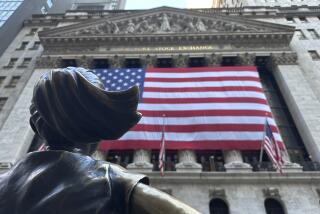Wall Street rebounds on last day of the quarter
- Share via
Wall Street’s spring rally resumed Tuesday to close out a winning March for stocks -- although the month’s advance reversed just a small amount of the damage from the long bear market.
For the first quarter overall, blue-chip indexes recorded their sixth straight quarterly decline, the longest streak of red ink in nearly 40 years.
Even so, diversified investors should find pockets of green in their portfolios in the quarter, as technology stocks, municipal bonds, gold and some other assets generated gains.
The Dow Jones industrial average rose 86.90 points, or 1.2%, to 7,608.92 on Tuesday, recouping part of the 254-point loss on Monday that was fueled by fears that General Motors Corp. and Chrysler could be headed for bankruptcy.
The Dow had been up as much as 203 points Tuesday before profit-takers swarmed.
For the month the Dow jumped 7.7%, its biggest monthly rally since it shot up 10.6% in October 2002 -- which marked the beginning of the last bull market.
Stocks have snapped back in the last three weeks after blue-chip indexes reached 12-year lows on March 9 amid extreme pessimism about the economy and banking system.
Some economic data in recent weeks have hinted that we may have put the worst of the recession behind us in the last quarter. And early last week investors cheered after the Obama administration detailed its plan to help private investors buy some of the rotten mortgages on banks’ books.
Sam Stovall, investment strategist at Standard & Poor’s in New York, said investors in March may have shifted from abject fear of the future to the sense that “one of these days the bear market will end and the economy will recover.”
Still, many Wall Street veterans warn that last month’s rally may turn out to be nothing more than a bounce within an ongoing bear market if the economy worsens.
Ryan Larson, head trader at Voyageur Asset Management in Chicago, said the market’s ability to hold on to recent gains may hinge on whether spring economic reports and news from the financial system lack the “shock-and-awe factor.”
Investors, he said, don’t need to see evidence of a recovery. “They just want to see signs that the economy has stabilized,” he said.
For the quarter, the Dow lost 13.3%; it’s now down 46.3% from its record high in October 2007, although it has surged 16.2% since March 9.
The Standard & Poor’s 500 index, which rose 10.34 points, or 1.3%, to 797.87 on Tuesday, was up 8.5% for the month but down 11.7% for the quarter.
Like the Dow, the S&P; index also has fallen for six straight quarters. The last such losing streak ran from early 1969 through mid-1970.
A few stock market sectors managed to finish in the black last quarter -- a big improvement from the fourth quarter, when every equity sector was bashed as the economy sank.
The Nasdaq computer stock index, which comprises 458 issues from Apple Inc. to Zoran Corp., gained 4.8% in the first quarter. And strength in tech names helped limit the Nasdaq composite index’s loss for the period to 3.1%. The index rose 26.79 points, or 1.8%, to 1,528.59 on Tuesday.
The tech sector is a classic bet on growth, so the stocks’ relative strength suggests investors are looking ahead to an economic recovery.
Most foreign stock markets slumped last quarter, but the four “BRIC” countries -- Brazil, Russia, India and China -- all posted gains in their main market indexes in the three months. Brazil was up 9%, Russia surged 25%, India edged up 0.6% and China jumped 30%.
As with tech, the strength in the BRIC markets can be viewed as a sign of faith in a rebound, analysts say.
A March snap-back in commodity prices, including oil, also helped boost stock markets in countries that are major raw materials exporters -- particularly Russia.
Crude oil futures in New York added $1.25 to $49.66 a barrel on Tuesday. The price rose $5.06 for the quarter.
Among other commodities, gold rallied $7.10 to $922.60 an ounce on Tuesday, lifting its gain for the quarter to $39, or 4.4%. The metal traded as high as $1,005 an ounce in February.
Gold has benefited from some investors’ fears that the trillions of dollars the government is throwing into the economy and financial system to stave off depression will lead to significantly higher inflation down the road.
Inflation jitters also helped to push up yields on U.S. Treasury securities last quarter, from record lows in December. The 10-year T-note yield ended Tuesday at 2.68%, down from 2.71% on Monday but up from 2.25% on Dec. 31.
Even as investors shied away from Treasuries, however, some flocked to municipal bonds, lured by rich tax-free yields after the bonds suffered heavy selling during the worst of the credit-market panic in the fourth quarter.
Mutual funds that focus on long-term California muni bonds were up about 5% in the quarter, including interest income and capital appreciation, according to Morningstar Inc.
--
More to Read
Inside the business of entertainment
The Wide Shot brings you news, analysis and insights on everything from streaming wars to production — and what it all means for the future.
You may occasionally receive promotional content from the Los Angeles Times.










